Jane Goodall
“Is this how it happens? We do what our friends do in order to be one of the group, to be accepted? Of course there are always some strong-minded individuals who have the courage of their convictions, who stand out against the group’s accepted norms of behavior. But it is probably the case that inappropriate or morally wrong behaviors are more often changed by the influence of outsiders, looking with different eyes, from different backgrounds.” Jane Goodall
“It’s not real connection. All it is – I call it common enemy intimacy, the only thing we have in common is we hate the same people….” Brene Brown
Today’s post has come about by my watching and reading things about and by British primatologist, anthropologist, ethologist, conservationist and UN Messenger of Peace, Jane Goodall. While engaging with the material I made some ink drawings using photos I found on the net.
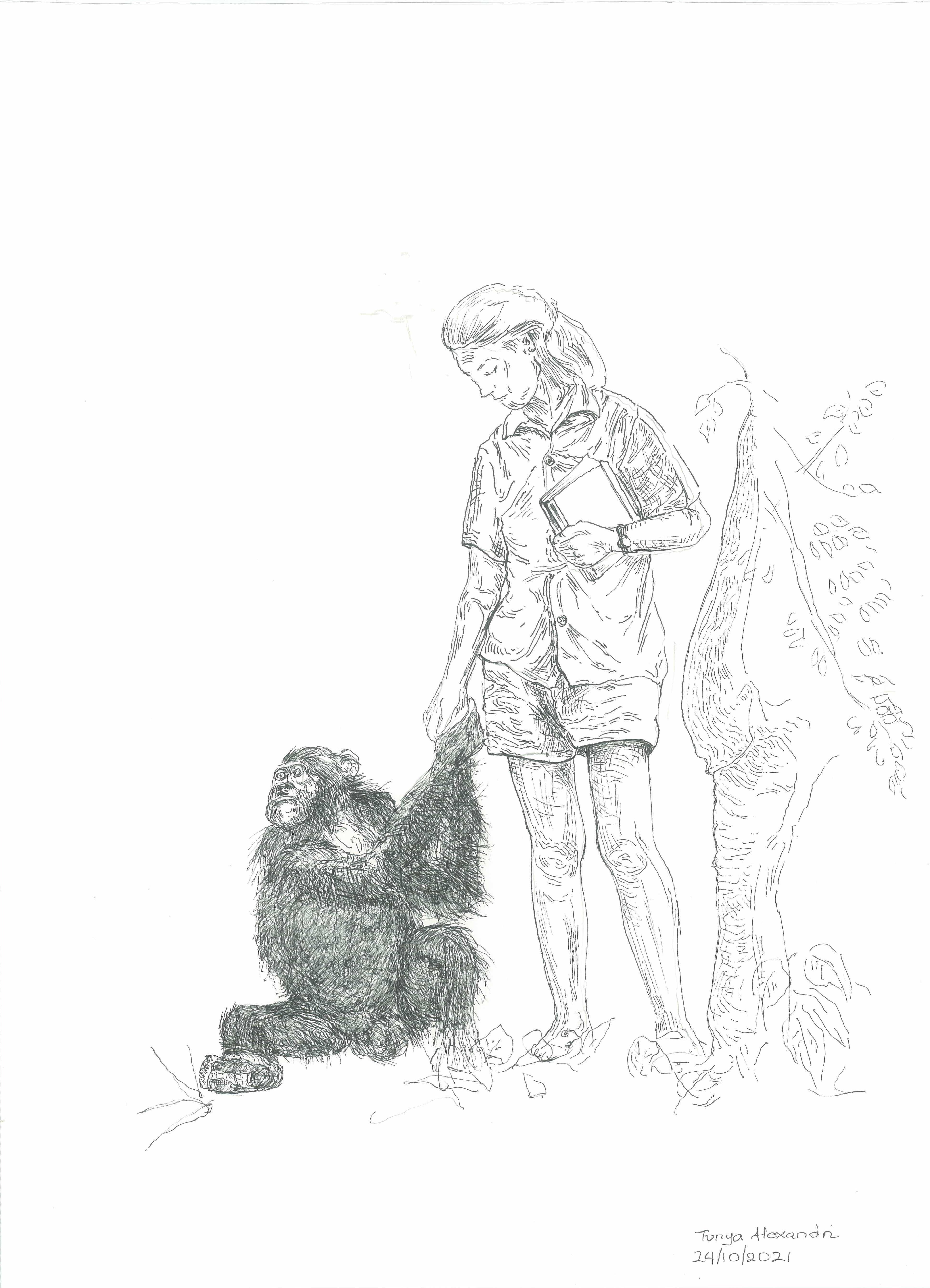
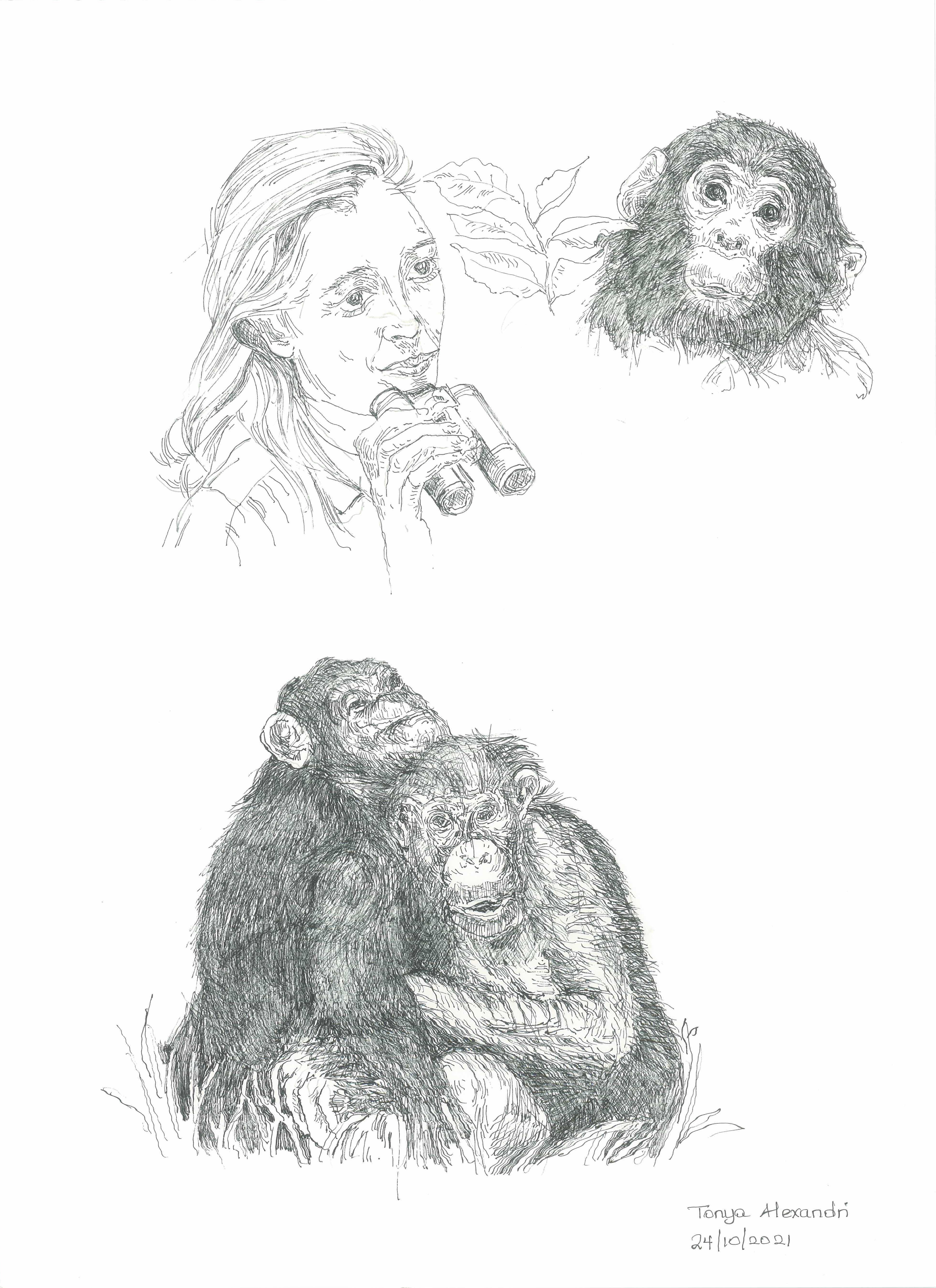
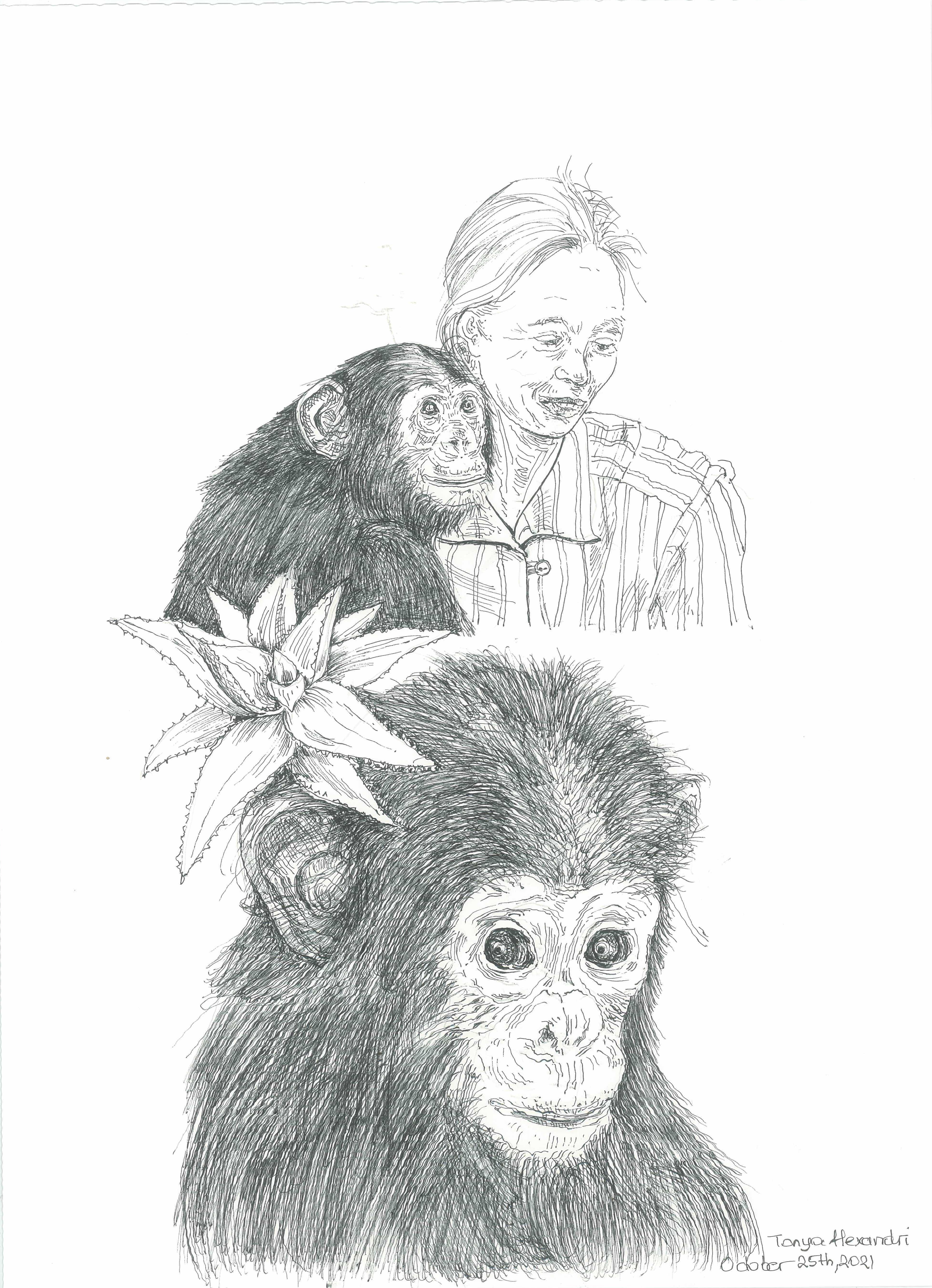
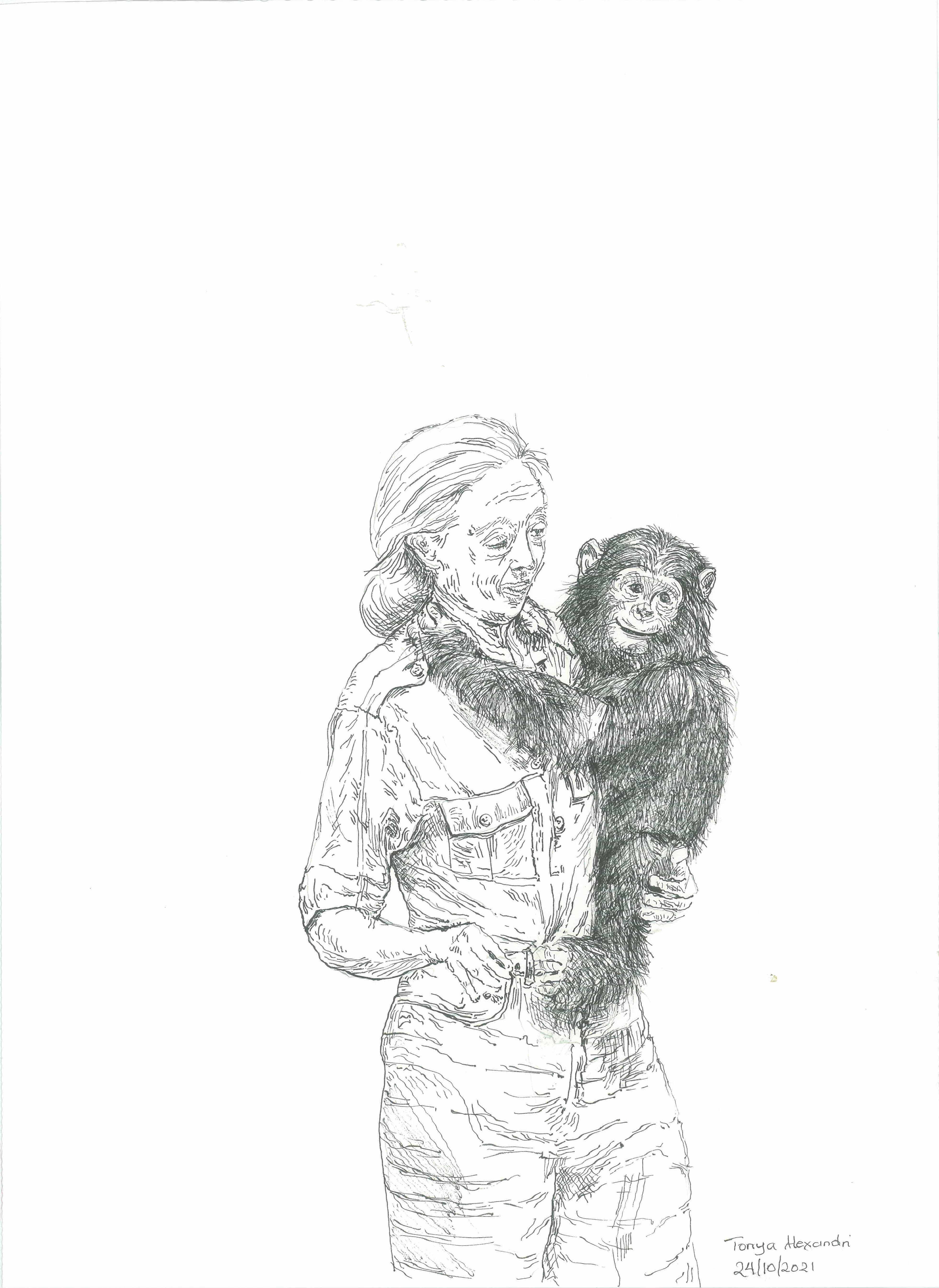
I’ll mostly be referring to her book: Reason for Hope: A Spiritual Journey (1999), which I chose to read because of its memoir aspect and exploration of hope simultaneously, even though it’s not her most recent one. This book takes us through the different phases of her personal and professional life and helps us understand how she has combined her spirituality and religious beliefs with science. I am aware that Goodall was 65 when she wrote this book twenty years ago and that environmental issues have deepened and increased, and technology and knowledge on evolution and other scientific matters have expanded greatly, and yet this book seems very relevant at the moment with so much going on in terms of the environment and loss of habitat for so many species. In her chapter Hope after referring to all the heart-wrenching global strife and conflict of that time she states her reasons for hope. She writes: “Yet despite this, I do have hope for the future… But only if changes are made in the way we live— and made quickly. We do not, I think, have much time. And these changes must be made by us, you and me. If we go on leaving it to others, shipwreck is inevitable. My reasons for hope are fourfold: (1) the human brain; (2) the resilience of nature; (3) the energy and enthusiasm that is found or can be kindled among young people worldwide; and (4) the indomitable human spirit.
She begins her book by wondering on whether to start her memoir at the point where she exited her mother’s womb and let out her first cry as oxygen entered her lungs or go back to her ancestors responsible for her genes or maybe with the historical and social events that shaped Europe in the 1930s and molded Hitler, Churchill and Stalin or maybe further back to the first truly human creature that was born of ape-men parentage and even further back to the first little warm-blooded mammal or to the first speck of life on planet earth, as a result of some divine purpose or cosmic accident. During the war she lived at her maternal grandmother’s house with her mother, sister, grandmother, aunts and people that the war had left homeless by the chaos and destruction in Europe. She writes that “all households were asked to find space for such unfortunates. And so the Birches, at that time, was an active place, filled with people of all sorts.” This took me back to war stories told to me when I was young by my mother. Her family lived in a village that served as the seaside resort for people from the nearby city and during the war some city dwellers were taken in by the people in the village. The war was what first brought home to Goodall that although her life was still filled with love and basic security, there was also another kind of world, “a harsh and bitter world of pain and death and human cruelty.” The Holocaust unsettled her even more deeply and inevitably questions arose. How could people behave that way? How could anyone endure and survive such torture?
Later on in the book when she talks about her upbringing Goodall writes “If only everyone could be blessed with such a childhood, such a family. How different, I believe, the world would be. As I look back over the sixty-five years of my life to date it seems that things just fell into place. I had a mother who not only tolerated but also encouraged my passion for nature and animals and who, even more important, taught me to believe in myself.” She writes she was provided with a mother wise enough to nurture and encourage her love of living things and her passion for knowledge: “I dreamed about nature, animals, and the magic of far-off wild and remote places. Our house was filled with bookshelves and the books spilled out onto the floor. When it was wet and cold, I would curl up in a chair by the fire and lose myself in other worlds.” Her love of primates might also have been sparked by a gift from her father when she was a toddler. Jubilee, a stuffed chimpanzee toy created to celebrate the birth of the first chimpanzee infant born at the London Zoo, became her most cherished possession. Looking back at her first voyage to Africa in her twenties she says: “Now the Kenya Castle [the ship] was carrying me forward into a new world, where the lessons would be taught by life itself in all its wonderful, sometimes tragic, often harsh, inconsistencies and surprises. And I could move into this new era without fear, for I was equipped, by my family and by my education, with sound moral values and an independent, free-thinking mind.”
The book also traces her spiritual and philosophical influences and questions around sensationalism and other ideas like endurance and torture. Questions like: Would I have the strength of mind to endure what Jesus and the martyrs suffered? How would I have withstood torture in the war? Could I have kept quiet to protect those I loved, those in my group, if nails pierced my flesh, if I was beaten, if I was on the rack? She writes: “I didn’t think I could endure, and I spent hours agonizing about it. Would I sacrifice my life for what I believed? There was, of course, no way I could be sure. To paraphrase what Eleanor Roosevelt once said: people are like tea bags; you never know how strong they are until you dump them in boiling water.” This part of the book also took me back to my own questions about serious life issues as I was growing up questioning many ideas floating around in my broader environment. During adolescence I had also started reading about the more recent history of Greece, with its darker pages of civil war, exile, persecution and torture. I too wondered if I had it in me to withstand torture to remain true to what I believed and what the human limits were and what war, trauma, imprisonment, exile and other human cruelties did to people.
A topic Goodall analyzes more extensively in the book over several chapters is aggression. She focuses more on the evolutionary perspective. During the first ten years of her study she had believed, as mentioned previously that the Gombe chimpanzees were, for the most part, rather nicer than human beings. She had observed aggression sometimes for seemingly trivial reasons, but for the most part she had found that aggression within the community is more bluster and threat than fierce fighting. Her study of them had shown that mostly relationships between chimps of a community are relaxed and friendly with frequent expressions of caring, helping, compassion, altruism, and most definitely a form of love. Chimpanzees are also intensely physical. When friends meet they may embrace and kiss each other. When they are fearful they reach out to touch each other, they pat each other, hold hands and engage in social grooming, and ties between family members are strong and enduring, and not just between mothers and their offspring, but also between siblings. They also adopt orphaned youngsters, and this behaviour has not only been observed in females, but males, as well. Some of these heart-warming stories of the chimpanzees that Goodall studied are found in her illustrated book With Love.
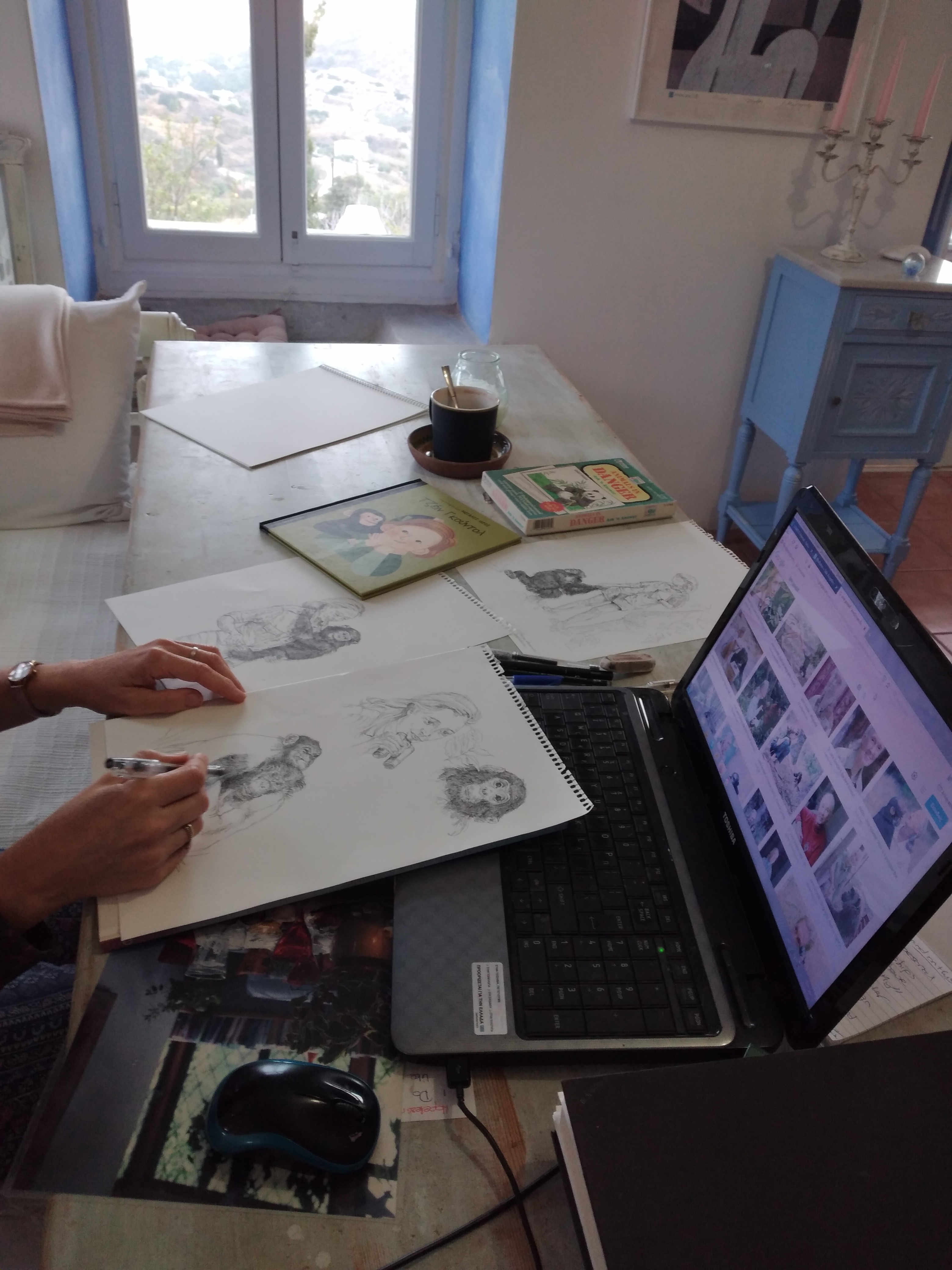
Then suddenly they found that chimpanzees had a dark side to their nature and they could be brutal. Goodall writes that at the time part of the scientific world wanted to remain in denial of this unpleasant fact. It was also the time of the nature versus nurture debate. There were those who vehemently believed that aggression was innate, coded in our genes; and those who held that a human infant came into the world like a blank sheet of paper upon which the events that occurred during its life would be etched and that this would determine the child’s adult behavior. She claims that while warfare in its typical human form is a cultural development, certain pre-adaptations must have existed in our earliest ancestors to permit its emergence. The most crucial of these adaptations would have included cooperative group living, hunting skills, territoriality, and the use of weapons. There would also need to have been an inherent fear of strangers, expressed by aggressive attacks.
Also, chimps like humans have a strong predisposition to act aggressively in certain contexts— jealousy, competition for food or sex or territory, fear, revenge, and so on. Their study had shown that the Gombe chimpanzees possessed these qualities. They were territorial and not only did they defend their territory, they also sometimes enlarged it at the expense of a weaker neighbor. Moving on to humans she writes that one of the most significant facts established about human behavior, as it relates to warfare and other acts of violence against conspecifics, is that cultural evolution permits the development of pseudospeciation. Pseudospeciation or cultural speciation, which was a new word for me, which simply means the transmission of individually acquired behavior from one generation to the next within a particular group. Over time this leads to the collective culture (the customs and traditions) of that group. It also means that the members of one group (the in-group) may not only see themselves as different from members of another group (the out-group), but also behave in different ways to group and non-group individuals. When this intensifies it leads to the dehumanizing of out-group members, so that they may come to be regarded almost as members of a different species. This frees group members from the inhibitions and social sanctions that operate within the group, and enables them to direct acts toward “those others” which would not be tolerated within the group. Slavery and torture at one end of the scale, ridicule and ostracism at the other. Something similar was observed among chimps. For instance, the Kahama chimps were treated as though they were prey animals, in other words, they were thoroughly “de-chimpized.”
Unfortunately, cultural speciation has become highly developed in human societies around the world. Our tendency to form select in-groups from which we exclude those who do not share our ethnic background, socioeconomic position, political persuasions, religious beliefs, and so on, is one of the major causes of war, rioting, gang violence, and other kinds of conflict. Jane Goodall writes that “cultural speciation had been crippling to human moral and spiritual growth…. Jesus of Nazareth had been very sensitive to the perils of in-grouping. Throughout his life he had attempted to expand the circle of his compassion to include people of all races, creeds, and social classes…..” She further emphasized how it had hindered freedom of thought and how it was a barrier to world peace. She claims that although there’s no harm in being part of a group because it can give us comfort & provide us with an inner circle of friends, it becomes dangerous once “we draw a sharp line, digging that ditch, laying that minefield, between our own group and any other group that thought differently.”
In some respects, human aggressive behavior is unique because even though it seems that chimpanzees have some awareness of the pain they inflict on their victims, they are surely not capable of cruelty in the human sense. Only we humans inflict physical and mental pain on living creatures deliberately and even more because we are aware of the suffering involved. But, it is also true that more than any other creature we are able or can learn to control our darker instincts. Goodall writes: “And are not the caring and altruistic aspects of human nature equally part of our primate heredity? What, if anything, I wondered, could our study of chimpanzees tell us about the roots of love … and whilst our biological nature and instincts can hardly be denied, we are, and have been for thousands of years, caught up in cultural evolution as well…. Are we, forever, to be torn in two different directions, cruel in one instance, kind the next? Or do we have the ability to control these tendencies, choosing the direction we wish to go?”…… “…if chimpanzees can control their aggressive tendencies, and diffuse the situation when things get out of hand, so can we. And herein, perhaps, was the hope for our future: we really do have the ability to override our genetic heritage. …. Our brains are sufficiently sophisticated; it’s a question of whether or not we really want to control our instincts.”
We can support each other to cultivate different ways of being, and as I have referred in many previous posts, science has shown that we are wired to be kind and compassionate and these are more beneficial states to rest in both for our physiology and emotional health, but also, for others. Goodall believes that the seeds needed to develop a compassionate and moral society are in us as human potential. She also notes that as a species we have come a long way in a very short time, and the fact that our species developed spoken language has enabled us to develop sophisticated moral, ethical codes of behavior. And this happened in all parts of the\world in all cultures by all peoples. She quotes Pierre Lecomte du Noüy , French biophysicist and philosopher, who as early on as 1937, stated that humans, having slowly and against all odds arrived and survived on planet earth, were in the process of acquiring the moral attributes that would enable us to become increasingly less aggressive and war-like and more caring and compassionate. This, he felt, was our ultimate destiny, the raison d’être for the human species.
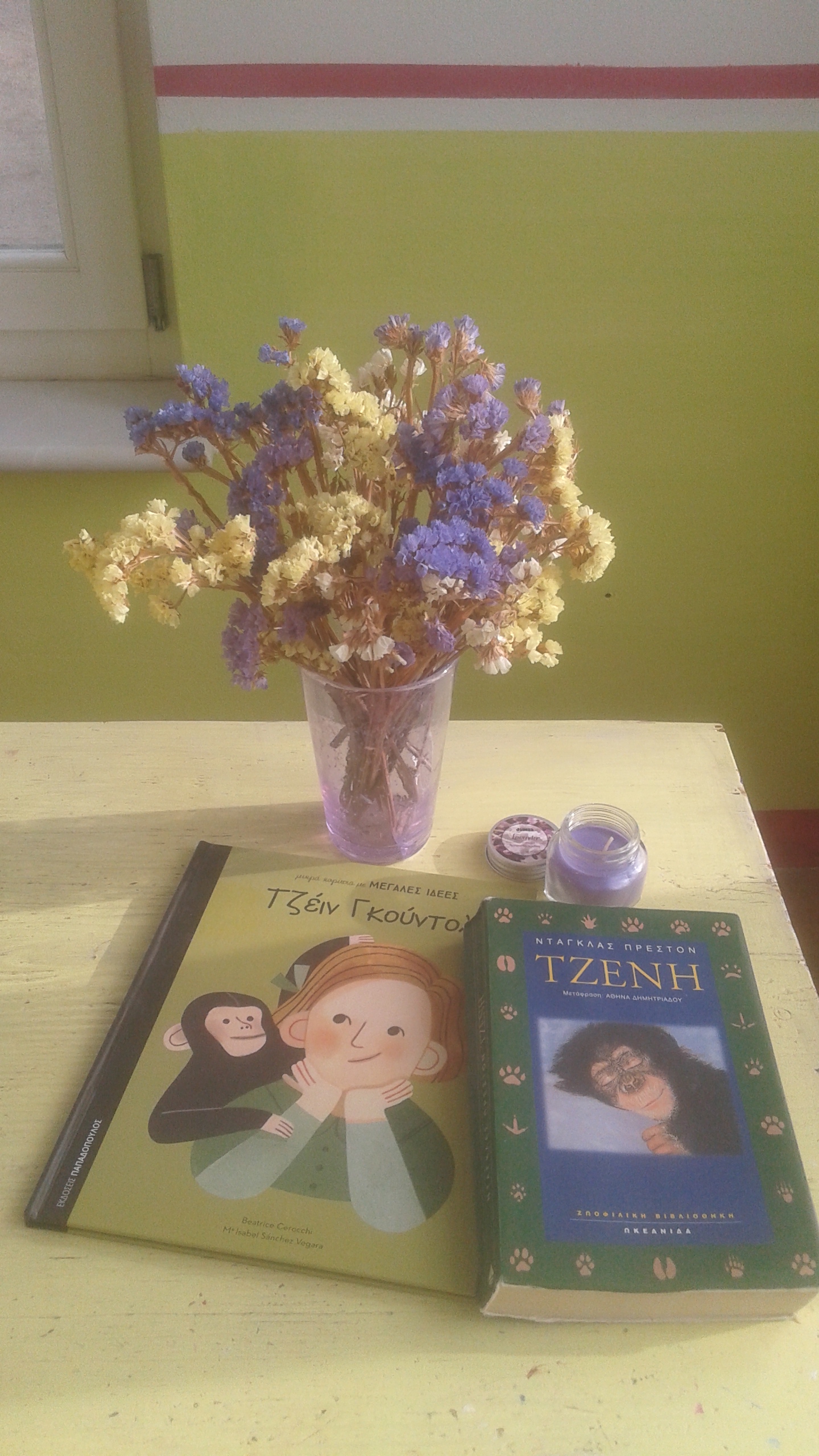
In the book there’s also a chapter on unethical by today’s standards scientific experimentations on animals, in which Goodall writes about some pretty harrowing stories of chimps in laboratories. She also refers to the fact that wild animals kept in captivity or as pets often cannot adapt to their wild habitats. This reminded me of the novel, Jennie, by Douglas Preston about a chimpanzee, the species that shares 98+ % of our DNA, which I must have read about 25 years ago or more. The novel is based on scientific findings and research at the time. So in this story a scientist encounters an orphaned baby chimpanzee while he’s on a research trip in Africa. He decides to bring the ape back to Boston and raise her alongside his own two young children as a kind of scientific experiment. Jennie believes herself to be human. She rides a tricycle, fights over the television with her siblings, wears clothes, communicates in American Sign Language and shows signs of grief over the death of her pet cat. Above all, she bonds with the family. All is well until she reaches adolescence…. The story is told from the different points of view of those closest to Jennie. The book asks the question: What does it really mean to be human?
Towards the end there’s a poignant passage in the novel that contains part of the farewell speech at Jennie’s burial after she has committed suicide banging her head against the bars of her small cage at the sanctuary she’s been taken after having been raised like a human within her human family. Sandy, her human brother, whom Jennie had created a deep bond is saying farewell to her.
“It is a great irony. With all these experiments they did, they almost managed to eliminate any difference between human and animal. The only thing they didn’t count on was Jennie’s ability to grasp the idea of death……… I made the arrangements for the ceremony. I chose an excerpt from “Farewell to Arms”, which was one of my favorite books when I was a teenager, and I memorized it, it is a book that deals with death ……. I’m not as crazy about Hemingway as I used to be, but I always liked this quote… .. Listen to what he says: “If people bring so much courage to the world that this world has to kill them in order to crush them, then of course it kills them. The law crushes each and all of us, but some become stronger at the wounded / broken places. But those it cannot crush, it kills. It kills the good ones and the most tender and the bravest, without discrimination.” That’s what Jennie was like. Good, tender and above all brave. She wanted to be a free human being or nothing. Without compromises.…… She was never going to accept being a caged animal or the mate of some chimpanzee on an island. Her death had courtesy and beauty. And it taught me a lesson: I will not let people crush me. And when I leave here I will have learned to carry my freedom in my heart …… ”
